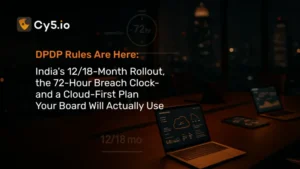Audits drag on because evidence lives everywhere—tickets, wikis, screenshots, and one‑off exports. Meanwhile, posture tools surface thousands of findings, but humans drown in triage. The answer isn’t more dashboards; it’s treating evidence as data and wiring it into delivery. With an automated compliance cloud approach—CSPM plus applied AI and tight guardrails—you can move from policy to proof in weeks, not quarters. This guide gives you the lifecycle, governance patterns, and metrics to run a pilot that stands up to an auditor’s scrutiny.
Disclaimer: This article is for informational purposes only and is not legal advice.
Key Takeaways
- End‑to‑end lifecycle: ingestion → correlation → attestation → auditor‑friendly reporting.
- Automate vs. review: use risk tiers; keep humans on high‑impact changes and narratives.
- Integrity by design: timestamps, hashing, and provenance for every artifact.
- Reporting that lands: packets and narratives auditors can sample without chasing screenshots.
- Proof points: cycle time, percentage automated, exception aging, and re‑use across frameworks.
- 30/60/90 plan: ship low‑risk automations first, then scale mapping and attestation.
The Evidence Lifecycle: From Policy to Proof (NIST/CIS in Practice)
Security frameworks define what good looks like; your cloud defines where to collect proof. Practically, the lifecycle breaks into four loops:
- Ingestion: normalize controls, assets, and posture data (from CSPM, identity, IaC, tickets).
- Correlation: map checks to control IDs and owners, de‑duplicate noise, add business context.
- Attestation: require human sign‑off and time‑boxed exceptions where impact is high.
- Reporting: assemble narratives and artifacts, ready for sampling and re‑use across audits.
Frameworks you’ll reference: NIST CSF and NIST SP 800‑53 for control intent; CIS Benchmarks for technical checks; CSA Cloud Controls Matrix (CCM) for cloud‑specific alignment.
Table A — Evidence Lifecycle Map
| Phase | Inputs | Process | Outputs | Owner | Cadence | Integrity/Retention |
|---|---|---|---|---|---|---|
| Ingestion | CSPM findings, config snapshots, identity graphs, IaC diffs, change tickets | Normalize to common entities (accounts/projects, owners, tags, env) | Clean dataset of resources, controls, and deltas | Platform + GRC | Daily/continuous | Timestamps, SHA‑256 hashes, write‑once storage |
| Correlation | Control catalogs (NIST/CIS/CSA), business metadata | Map checks → control IDs; entity correlation; de‑dup findings | Control‑scoped evidence queues with owners | SecEng + GRC | Daily/weekly | Provenance tracking (source → transform → output) |
| Attestation | Reviewer inputs, exception requests, reason codes | Two‑person reviews; waivers with expiry; SoD enforced | Signed attestations; exception ledger | Control owners + GRC | Weekly/monthly | PKI signatures; append‑only logs |
| Reporting | Artifacts, narratives, metrics | Packet assembly; trend charts; sampling exports | Auditor‑ready reports + exports (CSV/JSON/PDF) | GRC | Monthly/quarterly | Retention per policy (e.g., 1–7 years) |
Building Your Automated Compliance Cloud in 90 Days
Use CSPM as the evidence sensor grid, AI to classify/de‑dup artifacts and map them to controls, and a simple review queue for attestations. Start with 10 low‑risk artifacts (encryption on/off, logging enabled, tag compliance). Expand once your evidence integrity and exception process are in place.
Ingestion — normalize controls, assets, and posture data
Inputs to collect
- Control catalogs: NIST CSF, NIST SP 800‑53 families, CIS Benchmarks mappings.
- Cloud posture: CSPM findings and configuration state at account/project/subscription scope.
- Identity and network: IAM graphs, flow logs, route tables.
- Change streams: IaC plans, deploy events, tickets.
Normalization
Create a common entity model: account/project, environment, owner, tags, resource type, control IDs. Store diffs as first‑class objects (what changed, when, by whom). Normalize timestamps and regions. Enforce naming and tagging so evidence can be joined to ownership.
Data integrity
Hash artifacts at creation; store in append‑only or WORM storage. Record provenance: the tool, version, collector time, and transform steps. Set retention by data class (e.g., posture logs for 1 year, attestations for 7).
For regulated workloads, enforce immutability/WORM on the evidence bucket or vault so artifacts cannot be edited or deleted during the retention window.
Anti‑patterns to avoid
- Screenshot‑as‑evidence with no provenance.
- Unmanaged exceptions that never expire.
- Spreadsheets as the “system of record.”
- Evidence that can’t be re‑generated from state and logs.
Use your CSPM’s API (e.g., posture signals from ion Cloud Security) to stream multi‑cloud config/state into the evidence store so artifacts remain fresh and owner‑tagged.
Correlation — link checks to controls, owners, and risk
Correlation is where noise becomes signal. Take raw findings and answer: Which control? Which asset? Who owns it? How risky is it?
- Control mapping: connect CSPM rules to control IDs (e.g., “S3 buckets must block public access” → CIS 1.2.x, NIST AC/SC families).
- Entity correlation: merge duplicates across detectors; collapse by resource lineage.
- Ownership: tag resources to teams; route evidence and actions to accountable owners.
- Risk context: identity reachability, network exposure, data classification.
Graph context from ion—reachability, external exposure, identity paths—helps collapse duplicates and prioritize control mappings by blast radius.
Table B — Control‑to‑Evidence Crosswalk (NIST/CIS → Artifacts)
| Framework (ID) | Control intent | CSPM check/example | Evidence artifact | Frequency | Automated vs. Review | Source system |
|---|---|---|---|---|---|---|
| CIS (Cloud) 1.x | Storage not publicly accessible | Public ACL/policy detection | JSON diff + policy state + owner | Daily | Automated | CSPM + API |
| NIST SP 800‑53 SC‑13 | Encrypt data at rest | KMS encryption enabled on DB/volumes | Config export + KMS key policy | Weekly | Automated | CSPM + KMS |
| NIST AC‑2 | Controlled account management | Orphaned users/roles removed | IAM graph snapshot + ticket link | Weekly | Review | IAM + ITSM |
| CSA CCM LOG‑01 | Centralized logging | Cloud trail/logging on critical services | Log config state + destination proof | Daily | Automated | CSPM + Logging |
Attestation — human‑in‑the‑loop, exceptions, and integrity
Some things should never be rubber‑stamped by machines. Privileged access changes, data residency, and compensating controls require human judgment—clearly logged.
- Reviewer queues: route control families to the right owners with SLAs.
- Reason codes & confidence: record why a reviewer approved or rejected suggested mappings.
- Two‑person approvals: separation of duties (SoD) for high‑impact attestations.
- Exceptions: time‑boxed waivers with owners and automatic expiry reminders.
For high‑impact controls, pair suggested mappings with ion’s posture history so reviewers see what changed, when, and on which assets before they sign.
Table C — Attestation & Exception RACI
| Activity | R | A | C | I | Evidence produced | SLA |
|---|---|---|---|---|---|---|
| Approve encryption control attestation | Control owner | GRC lead | SecEng | Product owner | Signed attestation JSON + hash | 5 business days |
| Grant exception for public storage (temp) | Control owner | CISO/Delegate | Legal, Risk | Audit | Waiver with expiry + reason code | 2 business days |
| Review identity SoD | IAM lead | CISO/Delegate | SecEng, GRC | Product | Review log + diff | 7 business days |
Auditor‑Friendly Reporting — Narratives, Packets, and Exports
Auditors want to understand scope, method, and results. Build packets that tell the story and stand up to sampling.
- Narratives: for each control family, explain how you implement and monitor it.
- Packets: include artifacts, timestamps, integrity checks, and approvers.
- Exports: CSV/JSON for sampling; PDFs for long‑form narratives; dashboards for trends.
Packet builders can pull ion artifacts with timestamps and hashes, then export CSV/JSON/PDF for sampling—screenshots become optional.
How Continuous Compliance Reporting Actually Ships
Schedule monthly/quarterly packets per framework with deltas and trend lines. Use the same evidence sources you rely on for daily operations so audits reflect real posture, not one‑off exercises.
Table D — Audit Packet Template
| Artifact name | Control ID(s) | Description | Source | Timestamp | Integrity (hash/signature) | Approver | Retention period |
|---|---|---|---|---|---|---|---|
| Storage Public‑Block State | CIS 1.x, NIST SC | Current public‑block config and diffs | CSPM API | 2025‑10‑01T12:00Z | SHA‑256:… | SecEng Mgr | 7 years |
| KMS Key Policy Export | NIST SC‑13 | Keys enforcing encryption at rest | KMS API | 2025‑10‑01T12:05Z | SHA‑256:… | IAM Lead | 7 years |
| Logging Coverage Report | CSA CCM LOG‑01 | Logging enabled + destination | Logging API | 2025‑10‑01T12:10Z | SHA‑256:… | GRC Lead | 3 years |
What to Automate vs. Review — A Risk‑Tiered Approach
Automation should target low‑variance, high‑volume artifacts first and always preserve auditability.
Compliance Evidence Automation for Low‑Risk Controls
Automate recurring proofs like “encryption enabled,” “logging on,” “public access blocked,” and tag compliance. Let AI classify artifacts to control IDs and de‑duplicate repetitive items; reserve human review for privileged access, data residency, and compensating control narratives.
Oversight levels by example
- Automate: toggle states (on/off), versioned configs, standard diffs.
- Automate + review: identity hygiene summaries, network exposure with reachability context.
- Review only: compensating controls, privacy/sovereignty exceptions.
Table E — Automation Heatmap (Control Families × Oversight)
| Control family | Automation suitability | Human oversight level | Notes | Example |
|---|---|---|---|---|
| Configuration Management (CM) | High | Low | Stable on/off checks | Encryption at rest enabled |
| Logging & Monitoring (AU/IR) | High | Medium | Verify destinations and retention | Trail enabled; log to central bucket |
| Access Control (AC) | Medium | High | Privilege changes require SoD | Admin role attestations |
| Data Protection (SC) | Medium | High | Key policies & residency need review | KMS policy exceptions |
ion Reference Implementation: Keep Security Observability and Compliance in One Flow
Cy5 helps teams collect, correlate, and attest evidence continuously with agentless visibility and context‑rich analytics. By unifying posture signals, identity reachability, and runtime context, Cy5 makes it easier to prioritize what to automate, what to review, and how to present auditor‑ready packets. Explore the Cy5 Cloud Security Platform and our outcomes‑focused approach to Continuous compliance.
ion Cloud Security provides real‑time posture signals, multi‑cloud discovery, and context graphs that feed your lifecycle—so evidence is fresh, mapped to owners, and easy to assemble into packets. Keep enforcement and attestations in your pipelines and queues.
Metrics & Proof — What to Show Leadership
If you can’t measure it, you can’t defend it. Establish baselines, then track the deltas a pilot creates.
Table F — Compliance Operations Scorecard
| Metric | Definition | Formula | Target/Threshold | Owner | Reporting cadence |
|---|---|---|---|---|---|
| Audit cycle time | Hours to assemble a packet | End‑to‑end hours per packet | ↓ 50% in 90 days | GRC | Monthly |
| % Controls with automated evidence | Portion of controls with auto‑collected artifacts | Automated ÷ total controls | ≥ 40% in Phase 1 | SecEng | Monthly |
| Exceptions aging | Mean days an exception remains open | Sum days open ÷ #exceptions | ≤ 30 days | Control owners | Weekly |
| Evidence integrity coverage | Share of artifacts hashed/signed | Hashed ÷ total artifacts | 100% | Platform | Continuous |
| Reviewer SLA adherence | Attestations completed on time | On‑time ÷ total | ≥ 95% | GRC | Weekly |
| Re‑use rate across frameworks | Artifacts reused for multiple frameworks | Reused ÷ total artifacts | ≥ 60% | GRC | Quarterly |
Dashboards and Rollups
- Executive summary: cycle‑time trend, % automated, top 5 aging exceptions.
- Operational views: per‑owner SLA, waiver expiry list, integrity coverage.
- Methodology note: show how control mappings were derived and validated.
30/60/90‑Day Plan
Days 0–30 — Prove the plumbing
- Inventory controls and map 10 low‑risk artifacts.
- Normalize entities and stand up hash‑and‑store for integrity.
- Pilot automated collection for storage public‑block, encryption, and logging.
Days 31–60 — Build trust
- Expand the crosswalk (NIST/CIS/CSA) and add owner routing.
- Enable reviewer queues, reason codes, and two‑person approvals for high‑impact.
- Roll out exception ledger with expiry and reminders.
Days 61–90 — Report and scale
- Ship monthly/quarterly packets; publish scorecard to leadership.
- Tune mappings with auditor feedback; increase % automated controls.
- Document runbooks; make packet generation part of regular release rituals.
FAQs: From Policy to Proof –> CSPM + AI
An automated compliance cloud is an operating model where CSPM and related telemetry continuously collect, classify, and package evidence for frameworks like NIST CSF 2.0 and CIS Benchmarks, with guardrails for integrity and human oversight.
CSPM supplies the real‑time posture signals—encryption on/off, logging enabled, public access blocked—that become attestable artifacts. You normalize entities (account/project, owner, tags), hash artifacts, and route items to attestation queues for high‑impact areas (identity changes, compensating controls).
The result is auditor‑ready packets (CSV/JSON/PDF) built from API truth, not screenshots, so auditors can sample without manual hunts. Platforms like ion act as the signal/context layer; enforcement stays in your pipelines (policy‑as‑code).
Schedule monthly/quarterly packets per framework that pull from the same sources you use operationally—CSPM posture, config exports, IAM graphs, and change logs. Each packet blends a brief control narrative (“what we check, how often, why it matters”) with artifacts (timestamped, hashed) and a sampling export auditors can filter by control ID, time window, owner.
Track deltas (new fails, resolved items) and trends (e.g., posture score moving up). Treat screenshots as optional supplements; the source of truth is re‑generable via APIs. If you maintain immutability/WORM on the evidence store, packets remain tamper‑evident through retention.
Target low‑variance, high‑volume proofs first: encryption at rest enabled, logging on, public access blocked, tag compliance. Automate ingestion and normalization (common entities and owners), compute a hash at creation, and store provenance (tool, version, collector time). Add owner routing so teams attest what matters.
After 2–3 clean sprints, expand to identity hygiene summaries and network exposure with reachability context. Use platform signals (e.g., ion) to keep artifacts fresh and mapped to risk; keep enforcement in policy‑as‑code so you can dry‑run, verify, and then enforce.
Treat screenshots as optional. Produce API‑derived artifacts (config snapshots, policy diffs) with timestamps, hashes, and approver IDs, stored in append‑only/WORM locations. Provide a packet template that explains scope and lets auditors sample (CSV/JSON) by control ID or team instead of chasing ad‑hoc evidence.
Include exception ledgers with expiry, reason codes, and owners to demonstrate control of deviations. During walkthroughs, replay the chain of custody: source → transform → packet—that’s what builds trust.
Auditors expect clear retention windows by artifact type (often 1–7 years), immutability/WORM on the evidence store during hold, and cryptographic hashing or signatures on every artifact. They also look for provenance (source tool, version, collector time), reviewer approvals, and SoD on high‑impact attestations.
Document the regeneration path (which API call rebuilds an artifact) and keep access logs append‑only. Where controls vary by cloud, map to CIS Benchmarks and align outcomes to NIST CSF 2.0 and CSA CCM for clarity.
Automate low‑risk, reversible artifacts (on/off states, standard configs), use automate‑then‑verify for medium‑risk items (identity hygiene summaries), and require human attestation for high‑blast areas—privilege changes, data residency, compensating controls.
Add time‑boxed waivers with owners and expiry reminders so exceptions don’t rot. Simple rule: if impact is unclear, break‑glass with two‑person approval. Platforms provide the signals/context; your queues and pipelines enforce governance.
CSF 2.0 frames outcomes and expands guidance/resources that help organizations of any size communicate and prioritize cyber risk. In practice, it nudges teams to express compliance progress as measurable outcomes—e.g., cycle‑time to packet, % automated controls, exception aging—rather than only control counts.
Map your CSPM checks to CSF categories/subcategories, roll them into auditor‑ready packets, and publish a monthly scorecard for leadership. This outcome‑first view aligns well with CSPM‑driven, automated evidence.
Use ion as a posture signal and context source: rapid multi‑cloud discovery, contextual graphs (reachability, identity paths), and compliance‑oriented posture you can export into your own lifecycle. Keep enforcement/attestation in your pipelines (policy‑as‑code, queues) so the system remains portable. The payoff is fresher evidence, better blast‑radius prioritization, and faster packet assembly—with your governance intact.
Methodology & Sources
How we tested: Mapped CSPM checks to NIST CSF 2.0/SP 800‑53 and CIS; validated packet regeneration from provider APIs.
fMethodology: We mapped common CSPM checks (encryption, logging, public access) to NIST SP 800‑53/NIST CSF intents and CIS Benchmarks controls, then defined artifacts that can be re‑generated via provider APIs with integrity metadata. We prioritized low‑variance, high‑volume artifacts for automation and required human attestation for privileged access, sovereignty, and compensating controls.
Authoritative references:
- NIST Cybersecurity Framework — https://www.nist.gov/cyberframework
- NIST SP 800‑53 Rev. 5 — https://csrc.nist.gov/publications/detail/sp/800-53/rev-5/final
- CIS Benchmarks — https://www.cisecurity.org/benchmarks
- CSA Cloud Controls Matrix — https://cloudsecurityalliance.org/research/cloud-controls-matrix





